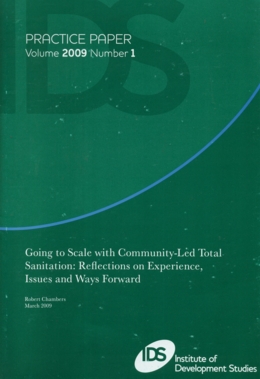 Perhaps as many as 2 billion people living in rural areas are adversely affected by open defecation (OD). Those who suffer most from lack of toilets, privacy and hygiene are women, adolescent girls, children and infants. Sanitation and hygiene in rural areas have major potential for enhancing human wellbeing and contributing to the MDGs. Approaches through hardware subsidies to individual households have been ineffective. Community-Led Total Sanitation (CLTS) is a revolutionary approach in which communities are facilitated to conduct their own appraisal and analysis of open defecation (OD) and take their own action to become ODF (open defecation-free).
In six countries where CLTS has been spread – Bangladesh, India, Indonesia, Pakistan, Ethiopia and Kenya – approaches differ organisationally with constrasting combinations of NGOs, projects and governments.
Practical elements in strategies for going to scale have included: training and facilitating; starting in favourable conditions; conducting campaigns and encouraging competition; recruiting and commiting teams and full-time facilitators and trainers; organising workshops and cross-visits; supporting and sponsoring Natural Leaders and community consultants; inspiring and empowering children, youth and schools; making use of the market and promoting access to hardware; verifying and certifying ODF status; and finding and supporting champions at all levels.
To spread CLTS well requires continuous learning, adaption and innovation. It faces challenges. Paradigmatically, it requires major institutional, professional and personal shifts. Opposition at senior levels, pressures to disburse large budgets, demands to go to scale rapidly, and programmes to subsidies hardware for individual rural households, have been and remain threats and obstacles. Issues for review, reflection and research include: diversity, definition and principles; synergies with complementary approaches; scale, speed and quality; creative diversity; and physical , social and policy sustainability. In seeking constructive ways forward, four key themes or thrusts are: methodological development andaction learning; creative innovation and critical awareness; learning and action alliances and networks, with fast learning across communities, districts and countries; and seeking to seed self-spreading or light touch movements. A key to good spread is findng, supporting and multiplying champions, at all levels, and then vision, commitment and courage. Contents: Summary Keywords and author note Acknowledgments Abbreviations 1. Context and Background
1.1 Purpose, limitations and critical reflection
1.2 Rural sanitation: the scale of the problem and opportunity
1.3 What is CLTS
1.4 Potentials of CLTS 2. Scale and country cases
2.1 Scale and statistics
2.2 Country diversity in patterns of spread 3. Practices found effective
3.1 Train and facilitate
3.2 Start in favourable conditions
3.3 Conduct campaigns, encourage competition
3.4 Recruit and committeams and full-time facilitators
3.5 Organise workshops and cross-visits
3.6 Support Natural Leaders and community consultants
3.7 Empower children, youth and schools
3.8 Make use of the market: promote access to hardware
3.9 Verify and certify ODF status
3.10 Find, inspire and support champions 4. Obstacles
4.1 Opposition of senior people
4.2 Institutional factors: inertia, big budgets and vested interests, and rapid scaling up
4.3 Individual household hardware subsidies (IHHS) 5. Issues for review, reflection and research
5.1 Diversity, definition and principles
5.2 Synergies with otehr approaches
5.3 Scale, speed and quality
5.4 Creative diversity
5.5 Sustainability: physical, social and policy 6. For the future: innovating, learning and sharing References Figures, tables and boxes
Post Date : 17 November 2009
|
